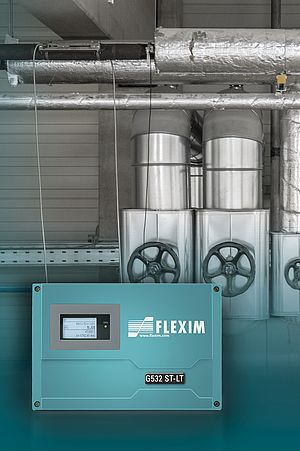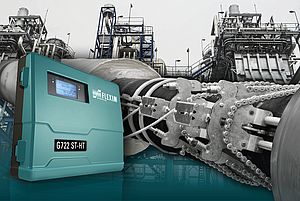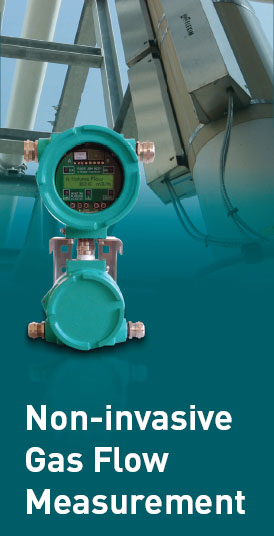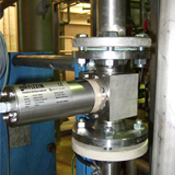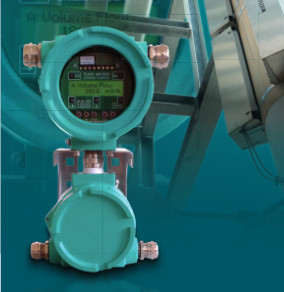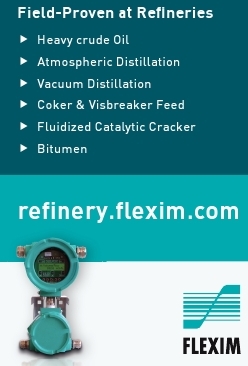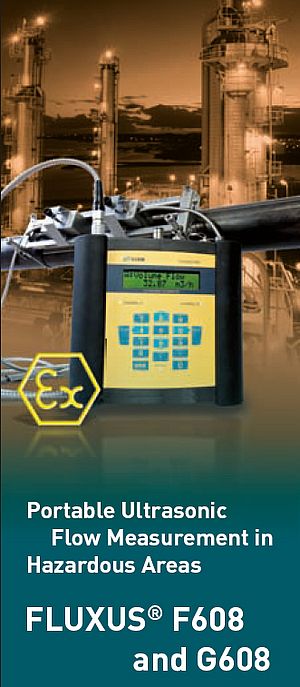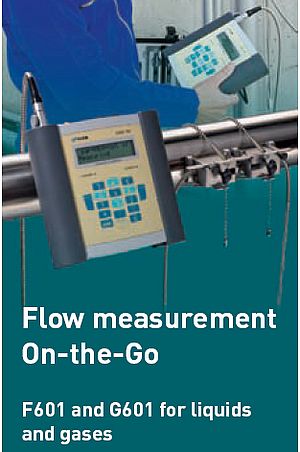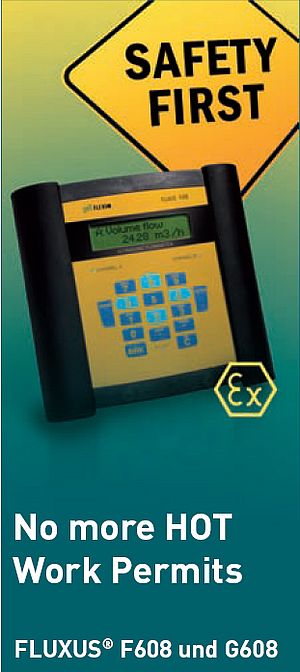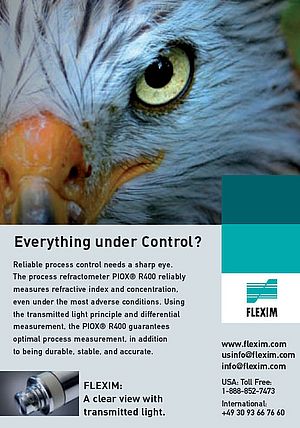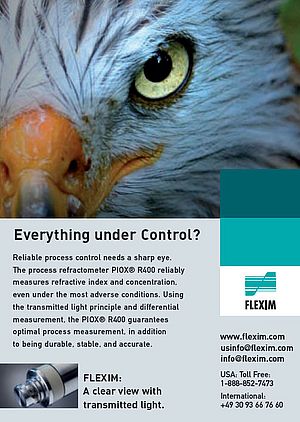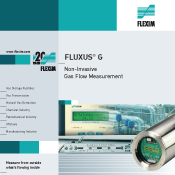At the moment, there only seems to be one trend on the market for flowmeters: Coriolis, forcing manufacturers to develop more powerful, smaller and cheaper Coriolis devices. But in many cases ultrasonic clamp-on flowmeters provide an ideal alternative.
"Going against the current is part of our measuring principle", says product manager Ingrid Panicke. In fact, non-invasive flow measurement with clamp-on ultrasonic transducers is based on the fact that an ultrasonic signal radiated into a medium flowing in a pipe, propagates faster in the direction of flow rather than against it. The difference between the signal transit times both in the direction of flow and against it, can be measured very accurately and is proportional to the flow velocity in the pipe. The measuring transmitter calculates the volume flow rate based on the geometric parameters of the measuring point entered and the physical properties of the medium which are stored in the internal media database.
Measuring from the safe side
In order to set up a flow measuring point with clamp-on ultrasonic technology, there is no need for any pipe work which means there is no production downtime. "Set up the ultrasonic transducers on the pipe, parameterize the measuring transducers and we're off", Ingrid Panicke sums up the process. However, the benefits of non-invasive measurement are by no means confined to its speedy installation: "clamp-on ultrasonic transducers are not subjected to any wear by the medium flowing in the pipe and they do not cause any pressure loss whatsoever", lists Ingrid Panicke as other advantages. "Last but not least, there isn’t even the slightest risk of leakage with non-invasive measuring equipment." In addition to that, the inertia-free, acoustic method has high measuring dynamics and works independently of the flow direction of the medium. Thanks to these advantages, non-invasive measurement technology has long been established as a standard method in the processing industry.
Especially in chemical processes the volume flow rate is often less interesting than the temperature and pressure-independent mass flow rate. The stoichiometric formulae of chemistry signify mass ratios. It is also a question of dosing the correct amount of substances in the form of mass proportions during the process on an industrial scale. "The fact that the phase displacement recorded on the vibrating tube of the Coriolis flowmeter is directly proportional to the mass, is quite undeniably a huge advantage of this measuring principle", states Ingrid Panicke, "it would be downright presumptuous to deny the advantages of Coriolis." Nonetheless, she isn't worried about the current arms race on the Coriolis market. "Just take a look at the special designs and materials available for Coriolis mass flowmeters. This shows exactly where the problem lies", she identifies the Achilles' heel of the wetted measurement process. "The wear over time can be quite intense in particularly challenging process conditions."
Volume times density equals mass
Particularly in the chemical industry where aggressive and toxic media are often used, plant operators like to fall back on non-invasive, clamp-on, ultrasonic technology. The fact that the ultrasonic flowmeter measures the volumetric flow rate is usually put into perspective quickly, as the volume and mass of a substance are linked by density. "Many processes are generally performed under constant conditions so that engineers can safely enter the density into the measuring transducer as a constant value and calculate the mass flow rate instead of the volume flow", says Ingrid Panicke. Non-invasive mass flow measurement is hardly more complicated, when only the temperature changes. In this case, just the temperature must be recorded on the measuring point and fed into the temperature input of the ultrasonic system. Since the physical parameters of the most common substances are already stored in the media database of the FLUXUS ultrasonic flowmeter, the temperature-density curve has to be recorded only in exceptional cases and programmed into the measuring transmitter. It is definitely more complex if the substance composition or the concentration in a mixture also varies. In this instance, PIOX process analytical systems are used.
Multivariable measurement
"One of the known advantages of the Coriolis meter is that mass flow rate and density can be measured simultaneously using the same device", states PIOX product manager Frank Gerstmann. "Unfortunately, the same benefit of our instruments is still rather unknown."
Just like the FLUXUS ultrasonic flowmeters, PIOX S process analytical systems work with clamp-on ultrasonic technology. If FLUXUS measures the transit-time difference of ultrasonic signals of substances flowing in the pipe both in and against the direction of flow, PIOX S also measures the transit times seperately and calculates, by factoring in the exact geometry of the measuring point, the acoustic velocity of the medium which by itself depends on the density and temperature and is a material-specific parameter.
The PIOX S MassFlow ultrasonic measuring system is effectively a combination of FLUXUS and PIOX S. It measures both the transit-time difference as well as the transit times themselves. In addition to that, the temperature is recorded. As of the fact, that in many cases the acoustic velocity of a medium correlates in a known function to its density, the mass flow can also be measured non-invasively if the density varies due to changes in the media temperature.
Standard application: acids
"Sounds more complicated than it is", says sales manager Dr. Jörg Wylamrzy, who he looks after the worldwide marketing of Flexim’s process analytical systems. "Some standard applications have already emerged from this, particularly, of course, for simultaneous concentration and mass flow measurement of highly aggressive substances such as acids." The Norwegian fertiliser company Yara uses FLEXIM’s non-invasive measurement technology on its filling stations to measure nitric acid. Nitric acid is traded in different concentrations. 68% and 60% nitric acid are most common. Lower concentrations are easily achieved by diluting with water. The dilution process is exothermic. Both the mechanical stress caused by the discontinuous filling processes as well as the thermal stress caused by rapid temperature changes meant that Coriolis meters, previously installed on the storage tanks, were unable to reach a satisfactory service life. Thanks to their positive experience with non-invasive ultrasonic measurement technology, Yara is fitting its nitric acid filling stations with the PIOX S MassFlow all around the world. In addition to that, clamp-on ultrasonic flowmeters are also used more and more in the production process itself, where they can show their full potential on large nominal diameters.
Another standard application for PIOX S MassFlow is the measurement of highly concentrated sulphuric acid. Dr. Wylamrzy has just returned from Riverside, Florida in the USA, where he was involved in retrofitting the sulphuric acid plants of Mosaic, the world market leader for phosphate fertiliser, to non-invasive ultrasonic measurement technology. He also takes a relaxed view of the current Coriolis euphoria. "Of course, the trend leans towards better and, therefore, more accurate measurements", Dr. Wylamrzy also states. "However, at the same time, there is a permanent trend towards maximum operational safety and plant availability. And we offer impressive solutions with FLUXUS and PIOX in this case."






